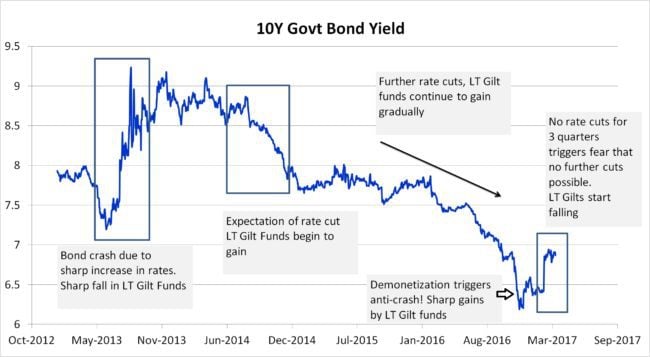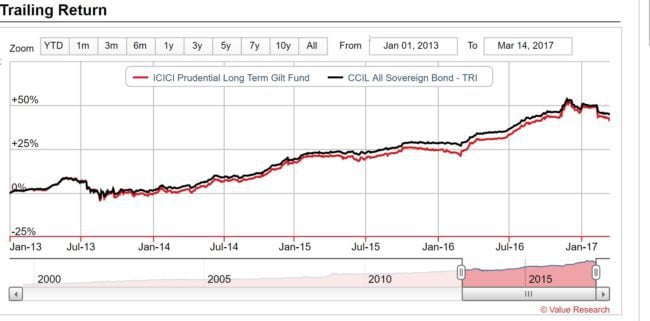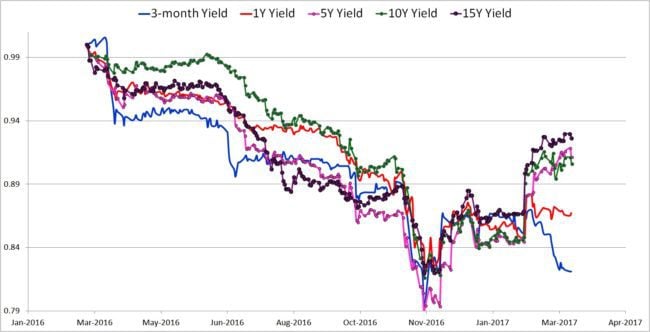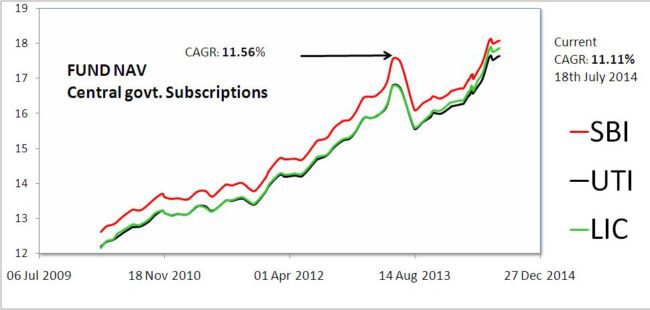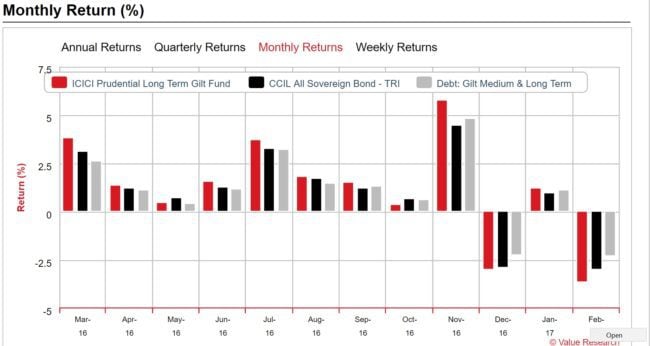Last Updated on October 8, 2023 at 1:40 pm
Many Investors, especially senior citizens, who purchased long term gilts funds (or their cousins, dynamic bond funds) after seeing recent double-digit returns, are puzzled and even worried about why these funds are falling since the last three months. In this post, I discuss the reasons behind this and how to make sense of debt fund NAV movements.
Before we begin, my book with PV Subramanyam, You Can Be Rich Too is available at 50 discount (Rs. 198) for short periods of time this month as it was among the top 25 bestsellers in the last 3 months. Grab it now!
Take the case of ICICI Long Term Gilt Fund. Suppose I notice that it had given a spectacular 17.98% returns in 2014 and put my money in early 2015, I would have got only a 5.53% return that year. If I saw the 18.17% return it made in 2016 and put my money in early Jan 2017, the fund would have lost 4.56% (in absolute terms) in the last 3 months. If I am shocked by this volatility, I have only myself to blame. I looked at returns without understanding the product. And you would be surprised how many people buy what they do not understand for unsuitable investment durations.
I have said it tens of times here and I will say it again. Long Term Gilt Funds are meant for opportunistic entry and exit. Sure, they can be part of a truly long -term portfolio (10+ years), but then I must understand that what they gain when the rates fall, they will lose when the rates rise – unless the fund manager can make a few smart buy and sell calls – theoretically possible.
Join 32,000+ readers and get free money management solutions delivered to your inbox! Subscribe to get posts via email! (Link takes you to our email sign-up form)
🔥Want to create a complete financial plan? Learn goal-based investing? Exclusive access to our DIY tools? Increase your income with your skills? Enjoy massive discounts on our robo-advisory tool & courses! 🔥
Debt fund investors should understand how the NAV of a debt fund can change:
(a) To reflect the interest income the bond in the folio receive, the NAV will increase a little each business day.
(b) Longer the duration of the bond, the more sensitive it will be to interest rate changes. If the rates decrease or if there is an expectation of a decrease, the value of the older bond (with higher interest) increase. This will show as an increase in the NAV of a debt fund. This is a capital gain.
On the other hand, if the rates increase, the old bond will lose value as new bond will have a higher interest rate. This will result in a capital loss for the debt fund.
Short-term debt funds like liquid funds and ultra short-term liquid funds have minimal risk of capital loss and minimal reward from capital gains. Their primary source of returns is from accrual or interest income. Higher the duration of the bond (be it a corporate bond or govt bond), higher the sensitivity of its market price to interest rate movements.
This can be measured by a quantity known as bond yield.
Bond yield = interest income/ current price.
For example a Rs. 1000 bond with 10% interest rate or coupon rate will provide an interest income or coupon amount of Rs. 100. Then the interest rate = yield. Rs. 1000 is the face value of the bond or value when it was issued. Due to market forces, the current price will change and hence so will the yield.
The yield represents the return you get from the bond. The return is just the simple coupon rate based on the current price. It is not the annualised return (this is calculated with a quantity known as yield to maturity or YTM). Read more about YTM here: How to buy tax-free bonds in the secondary market
When bond prices fall, like when interest rates being to increase, the yield will increase, and vice versa. Investors who like to hold dynamic bond funds or long term gilts funds can study bond yield movements from investing.com
Go to https://in.investing.com/markets/india
(copy url –> right-click –> “go to”) and select ‘bonds’ tab. The following yield information is from there.
It is important to keep in mind that bond price volatility is relevant only for debt funds and those who wish to sell in the secondary market. If a bond is purchased only for interest income and held until maturity. Then unless there is a default, there should be no issues.
The Inverse relationship between Yield and Long-Term Debt Mutual Funds
In July 2013, RBI hiked the short-term interest rate to stem the purchase of short-term bonds, reduce liquidity in the market and support the falling rupee. The above graph indicates this move with a sharp increase in 10Y yield. A rise in yield implies in fall in bond prices and hence fall in NAV.
Then the yield dropped due to the expectation of a rate cut. Therefore, there was not much movement when the rate was actually cut. Further rate cuts (arrow) results in a drop in yield. Then the demonetization triggered a sort of anti-crash. A sharp downward spike in yield leading to sudden gains in long-term yield.
However, there not been a rate cut since October 2016 and when the Feb. policy review meet also kept it unchanged, there was a sharp upward movement in yield.
That is, people now are expecting the rates to increase again. This means the demand for old bonds has come down. So they lose value and hence the yield increase. If you follow the above graph a couple of times, you can appreciate this relationship.
This is how ICICI Long term Gilt Fund behaved in this period (source: value research). You can correlate it with the above yield graph.
Here are different yield movements in the last year. Notice the sharp up move in long-term yield after Feb 8th (RBI meet).
The best time to buy long-term gilts is when you think rates will not increase any more and sell them immediately after a sizeable gain (with tax as per slab). Of course, not many can do this and way too often, people see the high return from LT gilts and then buy. That is closing the barn door after the horse has bolted. Or as the saying goes, if you can step on three daisies, it is already spring.
It is important to recognise that the concept of yield to maturity (annualised return if a bond is held to maturity) is of no relevance in open-ended debt funds. Here the fund manager will buy and sell and also the exposure to each bond will change because of inflows and outflows. As a result, the yield to maturity, the average maturity and the modified duration* of the portfolio will change on a month by month basis. Rendering the idea of yield to maturity irrelevant.
So you cannot hope that the fund manager will hold to maturity and that the interim volatility does not matter. Gilt bonds are available for up to 30-40 years. Do you really expect fund managers to hold for that long? Or more important, do you expect to stay invested (at least in the same fund) for that long?! The volatility that you see is a real risk if you need the money soon. Higher the average maturity of the bond, the longer it will take for a fund to recover from a crash.
NPS portfolios took a year-plus to recover from the July 2013 crash. This crash played its part in PFDRA decided to introduce deferred withdrawals.
I will update this graph to account for recent movements soon.
*The modified duration is a measure of how sensitive a bond is to in interest rate movements. You can learn more about this here: Understanding Interest Rate Risk in Debt Mutual Funds.
Here is an example of ICICI long term gilt fund portfolio for the last four months. In this time, the month returns were quite volatile (source: VR)
This is the portfolio (source fund factsheets). If you have trouble viewing it, here is the excel file.
Notice that the average maturity changes from 17 years to 23 years in four months! Each month, long term gilts were sold or purchased – either new ones or more of the same (observe the folio weights). Here 8.13% GOI 2045 means, a GOI bond maturing in 2045 with a coupon rate of 8.13%.
About 7 long term bonds were held constant over these four months, but the total exposure of these bonds changes from 68.7% in Nov 2016 to 90.71% in Dec 2016 and then back to 53.81% in Jan 2017 and 57% in Feb 2017.
I do not wish to speculate as to what the fund manager was trying to do, but it is clear that he was quite active!
You may have heard people talk about “reaping rewards if one stays invested over the long term” when it comes to equity funds. I don’t know about equity, but it is quite possible with long term gilts, with two caveats: (a) long-term means several years – I would say 10+ and (b) it will be quite a bumpy ride with the gains made during rate cuts almost erased during rate hikes.
Whether such unproductive volatility is needed or not, is a question that you need to ask. In any case, at least for all other purposes, I would recommend staying away from long-term gilts.
If you wish to learn more, download this Free E-book: A Beginner’s Guide To Investing in Debt Mutual Funds.
New Delhi DIY Investor Workshop April 23rd 2017
Register for the New Delhi DIY Investor Workshop April 23rd 2017
You Can Be Rich Too With Goal-Based Investing
Happy to announce that my book with PV Subramanyam has been selected as part of Amazon Best Reads Mar 2017. Now 50% off!. Thank you for your support and trust. If you have not yet got the book, check out the reviews below and use the links to buy.
Reader Quotes:
Gift it to your Friends and Relatives whom you care more. Already follower of Pattu and Subra’s forum. Ordered 4 more copies to give gift to my friends and eagerly waiting to read
The best book ever on Financial Freedom Planning. Go get it now!
Your first investment should be buying this book
The (nine online) calculators are really awesome and will give you all possible insights
Thank you, readers, for your generous support and patronage.
Amazon Hardcover Rs. 198. (50% off for a short period of time)
Kindle at Amazon.in (Rs. 307)
Google Play Store (Rs. 307)
Infibeam Now just Rs. 307 24% OFF.
If you use a mobikwik wallet, and purchase via infibeam, you can get up to 100% cashback!!
Bookadda Rs. 344. Flipkart Rs. 359
Amazon.com ($ 4.61)
- Ask the right questions about money
- get simple solutions
- Define your goals clearly with worksheets
- Calculate the correct asset allocation for each goal.
- Find out how much insurance cover you need, and how much you need to invest with nine online calculator modules
- Learn to choose mutual funds qualitatively and quantitatively.
More information is available here: A Beginner’s Guide To Make Your Money Dreams Come True!
What Readers Say
🔥Enjoy massive discounts on our courses, robo-advisory tool and exclusive investor circle! 🔥& join our community of 7000+ users!
Use our Robo-advisory Tool for a start-to-finish financial plan! ⇐ More than 2,500 investors and advisors use this!
Track your mutual funds and stock investments with this Google Sheet!
We also publish monthly equity mutual funds, debt and hybrid mutual funds, index funds and ETF screeners and momentum, low-volatility stock screeners.





- Do you have a comment about the above article? Reach out to us on Twitter: @freefincal or @pattufreefincal
- Have a question? Subscribe to our newsletter using the form below.
- Hit 'reply' to any email from us! We do not offer personalized investment advice. We can write a detailed article without mentioning your name if you have a generic question.
Join 32,000+ readers and get free money management solutions delivered to your inbox! Subscribe to get posts via email! (Link takes you to our email sign-up form)
About The Author
 Dr M. Pattabiraman(PhD) is the founder, managing editor and primary author of freefincal. He is an associate professor at the Indian Institute of Technology, Madras. He has over ten years of experience publishing news analysis, research and financial product development. Connect with him via Twitter(X), Linkedin, or YouTube. Pattabiraman has co-authored three print books: (1) You can be rich too with goal-based investing (CNBC TV18) for DIY investors. (2) Gamechanger for young earners. (3) Chinchu Gets a Superpower! for kids. He has also written seven other free e-books on various money management topics. He is a patron and co-founder of “Fee-only India,” an organisation promoting unbiased, commission-free investment advice.
Dr M. Pattabiraman(PhD) is the founder, managing editor and primary author of freefincal. He is an associate professor at the Indian Institute of Technology, Madras. He has over ten years of experience publishing news analysis, research and financial product development. Connect with him via Twitter(X), Linkedin, or YouTube. Pattabiraman has co-authored three print books: (1) You can be rich too with goal-based investing (CNBC TV18) for DIY investors. (2) Gamechanger for young earners. (3) Chinchu Gets a Superpower! for kids. He has also written seven other free e-books on various money management topics. He is a patron and co-founder of “Fee-only India,” an organisation promoting unbiased, commission-free investment advice.Our flagship course! Learn to manage your portfolio like a pro to achieve your goals regardless of market conditions! ⇐ More than 3,000 investors and advisors are part of our exclusive community! Get clarity on how to plan for your goals and achieve the necessary corpus no matter the market condition is!! Watch the first lecture for free! One-time payment! No recurring fees! Life-long access to videos! Reduce fear, uncertainty and doubt while investing! Learn how to plan for your goals before and after retirement with confidence.
Our new course! Increase your income by getting people to pay for your skills! ⇐ More than 700 salaried employees, entrepreneurs and financial advisors are part of our exclusive community! Learn how to get people to pay for your skills! Whether you are a professional or small business owner who wants more clients via online visibility or a salaried person wanting a side income or passive income, we will show you how to achieve this by showcasing your skills and building a community that trusts and pays you! (watch 1st lecture for free). One-time payment! No recurring fees! Life-long access to videos!
Our new book for kids: “Chinchu Gets a Superpower!” is now available!


Must-read book even for adults! This is something that every parent should teach their kids right from their young age. The importance of money management and decision making based on their wants and needs. Very nicely written in simple terms. - Arun.Buy the book: Chinchu gets a superpower for your child!
How to profit from content writing: Our new ebook is for those interested in getting side income via content writing. It is available at a 50% discount for Rs. 500 only!
Do you want to check if the market is overvalued or undervalued? Use our market valuation tool (it will work with any index!), or get the Tactical Buy/Sell timing tool!
We publish monthly mutual fund screeners and momentum, low-volatility stock screeners.
About freefincal & its content policy. Freefincal is a News Media Organization dedicated to providing original analysis, reports, reviews and insights on mutual funds, stocks, investing, retirement and personal finance developments. We do so without conflict of interest and bias. Follow us on Google News. Freefincal serves more than three million readers a year (5 million page views) with articles based only on factual information and detailed analysis by its authors. All statements made will be verified with credible and knowledgeable sources before publication. Freefincal does not publish paid articles, promotions, PR, satire or opinions without data. All opinions will be inferences backed by verifiable, reproducible evidence/data. Contact information: To get in touch, use this contact form. (Sponsored posts or paid collaborations will not be entertained.)
Connect with us on social media
- Twitter @freefincal
- Subscribe to our YouTube Videos
- Posts feed via Feedburner.
Our publications
You Can Be Rich Too with Goal-Based Investing
 Published by CNBC TV18, this book is meant to help you ask the right questions and seek the correct answers, and since it comes with nine online calculators, you can also create custom solutions for your lifestyle! Get it now.
Published by CNBC TV18, this book is meant to help you ask the right questions and seek the correct answers, and since it comes with nine online calculators, you can also create custom solutions for your lifestyle! Get it now.Gamechanger: Forget Startups, Join Corporate & Still Live the Rich Life You Want
 This book is meant for young earners to get their basics right from day one! It will also help you travel to exotic places at a low cost! Get it or gift it to a young earner.
This book is meant for young earners to get their basics right from day one! It will also help you travel to exotic places at a low cost! Get it or gift it to a young earner.Your Ultimate Guide to Travel
 This is an in-depth dive into vacation planning, finding cheap flights, budget accommodation, what to do when travelling, and how travelling slowly is better financially and psychologically, with links to the web pages and hand-holding at every step. Get the pdf for Rs 300 (instant download)
This is an in-depth dive into vacation planning, finding cheap flights, budget accommodation, what to do when travelling, and how travelling slowly is better financially and psychologically, with links to the web pages and hand-holding at every step. Get the pdf for Rs 300 (instant download)